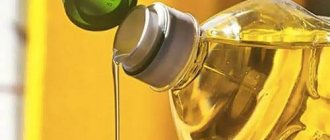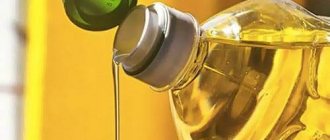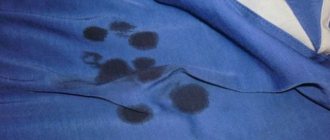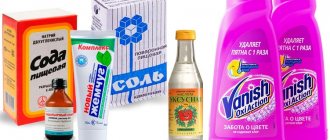Petrol
You will need:
- petrol;
- a cotton pad, a piece of clean cloth or cotton wool.
Process technology:
- Apply a little flammable product to cotton wool or a cotton pad. And use this disc to carefully walk over the fuel oil stain. When interacting, gasoline dissolves thicker fuel oil, which is partially absorbed into the cotton wool.
- If necessary, change the disc as many times as necessary until the mark becomes barely noticeable.
- If the contamination is severe and extensive, it would be a good idea to soak the entire pair of jeans in gasoline for two hours.
- After cleaning the jeans, hang them in the fresh air to air for several hours.
- To consolidate the result, wash the stain first with laundry soap, then run it in the washing machine with several rinses.
Note! For this method, regular fuel from a gas station will be ineffective. Therefore, you need to stock up on special gasoline - purified. You can buy it at a hardware store.
Advice! Instead of gasoline, you can use other flammable substances: diesel fuel or kerosene. The process technology is the same.
Useful tips for quickly removing fuel oil stains
To quickly and efficiently remove contamination, you must follow the following recommendations:
- It is better to soak a large area of contamination or completely soiled clothing in kerosene or gasoline.
- You can quickly remove a stain by placing a material underneath it that will absorb some of the fuel and lubricants. This will also prevent contamination from getting onto another panel.
- When choosing a cleaning method, you need to focus on the nature of the contamination, since for old stains only concentrated solutions are needed.
- After treating the contamination, it is recommended to wash the trousers 2-3 times by hand, only then in the washing machine at high temperature, if the fabric allows.
Toluene
You will need:
- toluene or a cleaning agent based on it;
- a cotton pad, a piece of clean cloth or cotton wool.
Process technology:
- Soak a cotton pad in a toluene-based product and apply to the stained jeans for 2-3 minutes. The fuel oil will begin to dissolve in toluene.
- Change the cotton wool to clean one and repeat the procedure several times until the fuel oil stain is completely removed.
- Wash with laundry soap.
Advice ! It is unlikely that toluene can be found in its pure form; it is used only in laboratory conditions. But toluene is included in a number of cleaning products or solvents for varnishes and paints. Cleaning of fuel oil contaminants with these means must be carried out in accordance with the instructions.
Important ! Don't forget about safety rules. Toluene is very toxic and also has harmful effects on the skin. Therefore, when working with it, you must wear a mask and gloves. The room in which cleaning is carried out must be well ventilated.
Effective solvents
First of all, its closest petroleum “relatives” – gasoline and toluene – are suitable for dissolving fuel oil.
Refined gasoline is used to remove stains, for example, to refill lighters or burners.
Refined gasoline is used for washing mechanical parts, degreasing various surfaces, and cleaning fabrics. It is sold in construction or hardware stores and its composition is noticeably different from that used to fuel cars.
Small stains of fuel oil are wiped off with a cotton swab dipped in pure gasoline. As soon as the tampon becomes dark, it is thrown away and the next one is taken. To absorb dissolved contaminants, place a layer of dry wipes or toilet paper under the stain being treated.
For large area stains, which are typical for work clothes (robes), in order to wash fuel oil, it is recommended to completely soak the items in gasoline for 1.5-2 hours. After this, they need to be washed several times, adding a little dishwashing detergent to the powder. The smell of gasoline will still remain, even despite repeated washing, so it is better to dry clothes outside or in a well-ventilated non-residential area for several days.
Many paint and varnish solvents contain toluene. They can effectively remove fuel oil stains
A petroleum product such as toluene is not sold in its pure form for household purposes, but is included in many solvents. When using a ready-made solvent, keep in mind that its pungent odor is not just unpleasant. Toluene is toxic, so all attempts to wash fuel oil with it should be made in a ventilated area, wearing gloves and (if possible) a respirator.
The action of solvents for many types of fabrics, especially colored ones, may be too aggressive. Conduct a preliminary safety test by applying a few drops of the selected product to an inconspicuous area of clothing on the underside.
Supermix for cleaning
You will need:
- turpentine,
- ammonia,
- White clay,
- starch,
- brush.
Process technology:
- Take the indicated “ingredients” in equal parts and mix thoroughly.
- Apply the resulting slurry to the fuel oil stain and leave for a couple of hours until it dries.
- Remove the dried mixture with a brush and wash the jeans.
This paste is not aggressive towards fabrics, so the likelihood of ruining the item is minimal.
Outerwear
Often, fuel oil stains appear on outerwear. In this case, the housewife has to look for a way to wash fuel oil from a down jacket, jacket or sheepskin coat. For cleaning outerwear, it is best to use the same products as for thin, delicate fabrics. In some cases, you can use car shampoo or make a homemade paste. They are good for processing down jackets and down jackets. It is not recommended to clean sheepskin coats from fuel oil at home. It is better to entrust it to professionals and take it to dry cleaning.
Removing oil stains is a troublesome and difficult task. Even if you manage to wash the substance from jeans or other clothing once, try to be more careful in the future and look around carefully. It may not be possible to bring the item into proper shape the second time.
General recommendations and rules
And finally, a few more tips for those who decide to remove oil stains at home:
- After treatment with chemicals, the fabric may lose color. To avoid this problem, apply the selected substance to an invisible area of clothing or a piece of similar fabric, and only then experiment on the jeans themselves.
- To avoid streaks, you need to clean from the edge of the stain to the center.
- When using flammable substances, stay away from fire.
- It is better to wash the stain from the wrong side.
As practice has shown, it is difficult to wash fuel oil from jeans. But still real. And you don’t have to run to the dry cleaner for this. If you know the technology, it is quite possible to get rid of pollution at home.
How to wash fuel oil from jeans: top 5 ways
Rules for dealing with stains
It is unlikely that you will be able to remove a fuel oil stain without strong agents. Therefore, in order not to damage the item, during cleaning you should adhere to the rules described below.
- To make sure that the fabric does not change color or damage its structure, be sure to test the cleaning product on an inconspicuous area of the clothing.
- Always clean from the edge of the stain towards the center.
- Place fabric or paper folded in several layers under the stain so that the stain does not transfer to the back of clothing or other things.
- To ensure that the outline of the stain does not remain after removing it, moisten the area around it with water before cleaning.
- First wash items contaminated with fuel oil by hand and only after the stain has been completely removed, put them in the washing machine with the rest of the clothes.
Useful tips. What is the easiest way to remove fuel oil from clothes?
Taking into account the fact that fuel oil stains are difficult to remove, you must always be prepared for the fact that even after using all the methods, the stains will remain. For better results, some rules will help you.
- Before using your solution on clothing, test it on a small area of similar fabric.
- You need to be very careful when using acetone to clean any fabrics.
- The cleaning solution should be applied from the edge of the stain to the center. This will help avoid streaks on the fabric.
- If solvents are used for cleaning, use rubber gloves to apply them.
- To avoid leaving an outline of the stain on the fabric, apply the solvent, touching a little on the area near the stain.
- If gasoline or alcohol is used to remove fuel oil stains, you need to dry the treated item as far as possible from open fire.
- To prevent the fuel oil stain from remaining on another part of the clothing, a clean, dense cloth should be placed under it.
If all the above procedures did not help, and the stain still does not come out, it is better to take the clothes to the dry cleaner.
There, specialists use special products that are not widely available. Professional equipment is also used to remove stains. Dry cleaning will return your clothes to their original appearance.
Traditional methods for removing stains
A common method is to soak it in a baking soda solution for an hour. To prepare it, 250 g of soda (half a standard pack) is diluted in 10 liters of water. Other methods also work effectively.
Starch
The following compositions are prepared on its basis:
| Compound | How to use |
| Starch+chalk | Mix half a teaspoon each of chalk and starch powders. Add a mixture of turpentine and ammonia (3 drops of each). Stir until smooth. Apply to stain. Let dry. clean with a brush. Wash as usual. |
| Starch + baking soda | Mix 1 tsp. ammonia and turpentine. Pour the mixture of dry ingredients into the resulting liquid (2 tablespoons of each). Apply in the same way as the first one. |
Ammonia and turpentine
They are used separately or mixed in equal volumes. The cleaning principle is the same in both cases:
- Dampen the oil stain using a cotton pad.
- Leave for 30-45 minutes.
- Wash by hand.
- Rinse in a weak solution of 9% vinegar (1 tablespoon per liter of water).
- Wash in the machine, doubling the amount of washing powder.
Acetone
When working with it you must wear gloves. Protect your respiratory system with a mask. Acetone liquid discolors fabrics. Therefore, it is not advisable to use it for jeans dyed with unstable dyes.
Toluene
It is not sold in its pure form. To split fuel oil, solvents R-4 and R-12 with a high (60%) toluene content are used. Using it for cleaning, you need to:
- Keep windows open:
- Wear gloves when cleaning;
- Protect your face with a gauze bandage.
Petrol
Used in extreme cases when there is no suitable alternative. Use, like ammonia, turpentine, acetone, toluene. Apply first to cotton wool and then wipe the oil stain.
Heated iron
Removes the bulk of fresh fuel oil. Place newspaper on the front and back of the jeans. Iron with a hot iron, changing the blotting paper several times. Remove the remains with essential oil. Complete processing by machine or hand wash.
Butter
Delicate product for removing fresh stains. Apply to the stained area for 15-20 minutes. Wash off with glycerin soap. Alternatively, you can use margarine.











